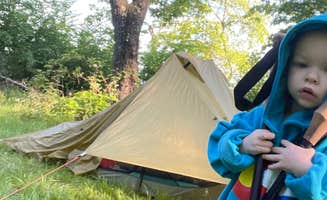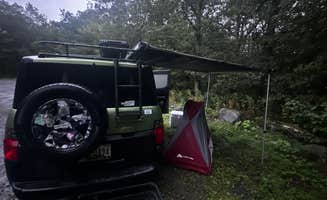Dispersed camping near New Tripoli, Pennsylvania offers primitive backcountry options within the eastern Pennsylvania highlands. This region sits along the Blue Mountain ridge of the Appalachian Mountains, with elevations reaching approximately 1,500 feet. The area's climate features distinct seasons with summer temperatures averaging 75-85°F and winter temperatures frequently dropping below freezing, requiring campers to prepare accordingly.
What to do
Hiking to viewpoints: The dispersed camping area at Bake Oven Knob provides access to significant elevation gains and rocky terrain. "The hike to the overlook is really lovely; short and rocky," notes camper Dani T., who frequently overnights in the area.
Trail exploration: Camping at Thunder Swamp Trailhead provides direct access to an extensive trail network. According to Jason R., "Tons of hiking. Went down Saw Creek trail to a marsh," making this location ideal for day hikes from a basecamp.
Wildlife observation: The Delaware State Forest area contains numerous wetlands and diverse ecosystems supporting various wildlife. The interconnected trail systems allow campers to access different habitat zones within relatively short distances, including marshes, forested areas, and ridge overlooks.
What campers like
Hammock-friendly terrain: Many sites feature suitable tree spacing for hammock setups. Katharine T. mentions at Appalachian Trail- Designated Backpacker Campsite 2 that there are "Good trees for hammocking" throughout the area.
Secluded options: Campers appreciate the ability to find isolation despite proximity to trails. "We camped nearer to others but there are secluded spots too," notes Katharine T. about the Appalachian Trail site, indicating flexibility for different camping preferences.
Bear protection infrastructure: Several sites provide bear boxes for food storage. Katharine T. reports that the Appalachian Trail site is "Well maintained w bear boxes provided," an important safety feature in this bear-active region.
What you should know
Water planning requirements: Water sources are scarce and seasonal. Regarding the Appalachian Trail site, Renee Z. advises to "Stock up on water at the Dunnfield creek natural area, or wait until Sunfish pond," indicating the need for carrying water or planning routes around reliable sources.
Parking regulations: Some areas permit overnight vehicle stays while others require hiking in. Benjamin H. notes that Thunder Swamp Trailhead is "a gravel parking lot. Plenty of shade. No one bothered me," suggesting this location may work for those seeking vehicle-accessible dispersed camping.
Terrain limitations: Many sites feature challenging, uneven ground. Renee Z. describes one Appalachian Trail site as "a little on the small and sloped side for tent camping," highlighting the importance of site selection when using tents.
Tips for camping with families
Safety considerations: Steep terrain and rocky outcroppings require close supervision of children. Areas like Bake Oven Knob feature exposed cliffs that present significant fall hazards, particularly in wet or icy conditions.
Distance management: Plan hiking distances appropriate for children's abilities. The varied terrain means elevation gains can be significant even over short distances, making actual hiking effort greater than mileage suggests.
Wildlife awareness: Teach children proper food storage and garbage management. The bear boxes mentioned at some sites should be used consistently, even during daytime activities when away from camp.
Tips from RVers
Size restrictions: Large rigs cannot access most dispersed sites in this region. At Thunder Swamp Trailhead, Jason R. describes the area as "Trailhead parking was chill for a night," but notes it's suitable only for smaller vehicles.
Leveling challenges: Bring leveling blocks as most parking areas have uneven surfaces. Benjamin H. confirms that the Thunder Swamp area is "a gravel lot," indicating potentially uneven surfaces requiring adjustment for comfortable overnight stays.
Generator restrictions: Most areas prohibit generator use to preserve the wilderness experience. Plan for alternative power sources or prepare for no-electricity camping, as these areas focus on primitive, low-impact wilderness experiences.



